The project envisages the upgrading and speeding up of the Naples-Bari route, which will allow the southern railway infrastructure to be integrated with the Scandinavia-Mediterranean Core Corridor.
The main objective is to speed up the current connection and improve accessibility to the service in the areas crossed, both for national long-distance services and for regional and freight services.
Upon completion of the work, the Naples-Bari link will be travelled in 2 hours, compared to about 4 hours today, whilst the Rome-Bari link will take 3 hours, as a saving of about two hours compared to now.
The work represents a great job creation engine. More than 7,000 people are involved in the project, including engineers, technicians and workers.
Roberto Pagone was appointed Extraordinary Governmental Commissioner for the works. The commissioning of the Naples – Bari line has made the acceleration of the various steps necessary for the completion of the work possible, with shorter authorisation processes and deliverables, to reduce costs and times of completion. In addition, a special Task Force has been created to monitor the progress of the projects and examine any critical issues, in order to reach their resolution in compliance with the deadlines and costs defined in the Commissioner's Planning.







